Archives
now browsing by author
Lenape Life

Lenape life has been preserved in stories, dances, ceremonies, and the daily life of thousands of present-day Delawares. These pages present some of these traditions.
- Some of the Ways of the Delaware Indian Women
- Lenape Football Game (PDF)
- Rabbit Tail Game
- Villages
- Family
- Foods
- Stories
- Fishing
- Canoes
- Pottery
- Lenape Indian Medicines, by Glenn McCartlin and Jim Rementer (PDF)
- Delaware Ethnobotany, by George Hill (Re-edited 2015 by George Hill and Jim Rementer; PDF)
- Gifts of Food by American Indians, by Jim Rementer (PDF)
- Fish Festival of the Indians, by A.R. Dunlap and C.A. Weslager (PDF)
- Lenape Funeral Customs (PDF)
- Artwork by Lenape Artists (PDF)
- The Spiritual World of the Lenape or Delaware Indians (PDF)
- Delaware Indian Dance Rattles Made of Coconuts (PDF)
Social Dances of the Lenape and Other North-Eastern Indian Tribes

By Jim Rementer and Doug Donnell. In Remaining Ourselves: Music and Tribal Memories, edited by Dayna Bowker Lee, pp. 37-41. Traditional Music in Contemporary Communities series. Pubished by the State Arts Council of Oklahoma, 1995.
It is a beautiful night. Somewhere in the Lenape homeland there is a large gathering of people who have come together for a ceremonial. It took place during the day, and now the sun has set. Inside the dance area the attendants have brought in the fire. People are sitting around visiting, and waiting. Then, the deep, resonant sound of the water drum begins. A steady beat is soon followed by the singing of the drummer. He is singing a song for the women to come out and dance. On either side of him sit other singers. They have gourd rattles, or other types of rattles, and they too sing along. The world is a wonderful place, the year is 1494, and the world of the Lenape and other Native people is about to suffer a drastic change.
The scene we set above could have taken place almost anywhere in the east, from New York on south, perhaps as far as the Gulf of Mexico. Even to this day many of the old “Social Dance Songs” are remembered, and are still used by some tribes. What type of music is this, and how does it differ from modern-day pow-wow songs? Dr. Charlotte Heth, a Cherokee and an ethnomusicologist has stated some of the common aspects:
We can generalize fairly easily about the characteristics of Eastern and Southeastern music and dance today:
- Dances are performed in a counter-clockwise manner, for the most part.
- Instruments are either worn on the body, held in the hand and shaken, blown, or beaten upon. The primary drum was and is the water drum.
- Singing is either responsorial with leader-chorus alternation, or is unison chorus after the leader has “lined out” the beginning of the song. Strophic songs with alternating chorus and verse parts are also common.
- Songs tend to be short, while performances are long, have many repetitions, and/or are arranged in cycles (Heth 1992:174).
The Musical Instruments
The drum the main singer uses is what is called a “water drum.” Many of these were made from a small hollowed log, and there is some water placed in the bottom to create the resonance. For some tribes this drum may be made from pottery, and for still others it may be a cypress knee which has been hollowed out (Medford 1972:14).
The earliest description we have of the water drum is from the Powhatan tribe of Virginia in 1612. We find that the drums “were made of deep wooden platters covered with animal skin. To the corners of the skins were attached walnuts, which were then pulled beneath the platter and tied with a cord.” There is no mention of whether the platter contained water, but later in the same century there is a mention of the Powhatans using “drums consisting of skins stretched over pots half filled with water” (Rountree 1989:97).
In later years the drum was made from crocks, barrels, or three-legged kettles with a drumhide stretched over them. For example, the drum used by the Delawares in 1780 was described as, “The drum which keeps the time is a thin deer-skin stretched across a barrel, or, in lieu of this, a kettle” (Zeisberger 1910:18). Today the preferred drum is a made from no. 6 cast iron kettle. One of the most common uses nowadays for the water drum is as the drum used in the Native American Church. However, long before the Native American Church was organized, water drums sounded throughout the East and Southeast.
In addition to the water drum, the other principal musical instrument was the rattle. Among the Iroquois and Delaware rattles could be made of gourds, bark, horn, and turtle shells; however, turtle shell rattles were most often used in ceremonies and not for Social Dances. In addition to using all of these materials, in more recent times the Shawnees and Delawares adopted the use of coconut shells for rattles. Among the Powhatans the “rattles … were made of gourds and graded in size and pitch” (Rountree 1989:97).
The Social Dance Songs
The songs which the water drum accompanied, the “social dance songs,” cover an immense area, and the same basic songs are used from tribe to tribe to tribe. At this late date it is very difficult to try to determine a tribal origin for most of these songs. It is made even more difficult as most of these songs have vocables instead of words.
Some songs take the names of foods, such as Bean Dance or Corn Dance. Some are named after animals, like the Raccoon Dance and Duck Dance. Even the Alligator Dance spread as far north as New York and Canada among the Iroquois people, but what was the origin? We can probably say with a certain degree of safety that alligators did not exist in New York State, so it must have been brought north by one of the Southeastern tribes. Some of these tribes were taken into the Iroquois Confederacy.
Some of the dances were named for other tribes, such as the Cherokee Dance. This is used very commonly by the Shawnee, Delaware, and Caddo, but it seems not to be known by the Cherokees. Of more recent origin there is the Quapaw Dance, used by the Delaware, Shawnee, and Caddo.
Some of the songs have strange names, such as Stirrup Dance, in which a man dances with a woman partner, and at a certain point in the song the man raises his foot and the woman places her foot on top of his, almost as if she was putting her foot in a stirrup, and they hop and dance. Another dance with a peculiar sounding name is the “Go-Get-‘Em Dance” in which the women gather in front of the men singers, and sing along with them. After about four songs the men come dancing in and they each get a woman to dance around the fire.
Why the Dissemination
Many of these songs traveled from east to west as various tribes were forced out of their original homelands. Some of these songs, such as the Duck Dance, have a very wide range. It should be mentioned that songs which were of a religious or ceremonial nature to a tribe almost never seem to have been transferred from tribe to tribe.
In some cases the dances were given to other tribes with permission to use them, such as the Caddo giving the Turkey Dance to the Delawares and Shawnees. As this is not a dance of eastern origin, when it is done the dancers move in a clockwise direction (as the Caddo do). The authors feel that, given the evidence presently available, most of the songs which the Caddo dance in a counter-clockwise direction were probably learned from the Delawares and Shawnees. Most likely this took place while the three tribes were together in Texas during the last century. Another example of a dance being given to other tribes is that as recently as 1927 the Quapaws gave the Quapaw Dance to the Delawares and Shawnees (Blalock, pers. comm.).
Sometimes the dances are given to another tribe to “keep” for the tribe doing the giving. At a recent conference in Muncey, Ontario, a Munsee-Delaware woman told how her people had given the “Delaware Skin Beating Song” to the Oneida to keep for them as they were losing their singers. This song continues as part of the songs used by a number of Iroquois singers.
Frank Speck mentions that a Cayuga man from Canada made a trip to visit the Delaware while they were still in Kansas (prior to 1867), and he returned home with the Stirrup Dance. It has since been renamed “Chicken Dance” or “One-Side Male Dance” (Speck 1937:154).
At the end of this page is a list of the common Social Dance Songs. The basis for this is a list (column one) by Lewis Henry Morgan of the songs done by the Delawares in Kansas in 1859. He did a similar list for the Shawnees and it is in column six. Most of the names for the dances as given are taken from Morgan. Songs found on his original list are indicated by an X in the first column marked “Morgan 1859.” To this list we have added some of the more recent songs, or songs he neglected to name. The first five columns are of Delaware dances. This is followed by two columns of Shawnee Dances, one column of Iroquois Dances, and one of Caddo Dances.
The information in this article is just a beginning. It is our hope that our Indian people and the scholars will continue the research into these beautiful songs, and that they will be preserved for the future generations.
Bibliography
Adams, Robert. 1991. Songs of Our Grandfathers: Music of the Unami Delaware Indians.Touching Leaves Indian Crafts, Dewey, Oklahoma.
Blalock, Lucy. Personal communication, 1994.
Hale, Duane K. 1984. Turtle Tales: Oral Traditions of the Delaware Tribe of Western Oklahoma. Delaware Tribe of Western Oklahoma Press, Anadarko, Oklahoma.
Heth, Charlotte. 1992. The Arts in America in 1492. In Selected Lectures from the Quincentenary Program, Occasional Papers in Curriculum Series, no. 15.
Howard, James H. 1981. Shawnee! Ohio University Press, Athens, Ohio.
Kurath, Gertrude Prokosch. 1956. Songs and Dances of the Great Lakes Indians. (Side II, Iroquois). Ethnic Folkways Library, Album FM 4003, Folkways Records Corp., New York.
Medford, Claude Jr. 1972. Southeastern Drums. In American Indian Crafts and Culture, November 1972, pp. 14-16.
Morgan, Lewis Henry. 1993. The Indian Journals 1859-62. Dover Publications, Mineola, New York.
Newkumet, Vynola Beaver, and Howard L. Meredith. 1988. Hasinai: A Traditional History of the Caddo Confederacy. Texas A & M University Press, College Station.
Rountree, Helen C. 1989. The Powhatan Indians of Virginia: Their Traditional Culture. University of Oklahoma Press.
Speck, Frank G. 1937. Oklahoma Delaware Ceremonies, Feasts and Dances. Memoirs of the American Philosophical Society, vol. VII.
Speck, Frank G. 1949. Midwinter Rites of the Cayuga Long House. University of Pennsylvania Press.
Zeisberger, David. 1910. History of the Northern American Indians. Ohio State Archaeological and Historical Society, vol. XIX.
Endnote
The Lenape had many other songs which were used in various ceremonies. They also have war dance songs, songs used for various things around the home, and of more recent times, songs of the Native American Church. Over the years the various missionaries working among the Lenape have also translated nearly 1,000 hymns into the Lenape language. The topic of this writing in the Social Dance Songs, so we will not discuss these other songs at this time.
A List of Songs Attributed to the Eastern Indians from Various Sources
| TRIBE–> | Delaware | Delaware | Delaware | Delaware | Delaware | Shawnee | Shawnee | Iroquois | Caddo |
|---|---|---|---|---|---|---|---|---|---|
| SOURCE–> | Morgan | Speck | W.Del | E.Del | Lucy | Shawnee | Shawnee | Iroquois | Caddo |
| DATE–> | 1859 | 1935 | 1975 | 1977 | 1994 | 1859 | 1970 | 1950 | 1988 |
| Adoption Dance [Dance of Dead] |
X | — | — | — | — | X | — | X | — |
| Alligator Dance | — | — | — | X | — | — | X | X | X |
| Bean Dance | — | X | — | X | X | X | X | X | X1 |
| Bear Dance | X | — | — | — | X | X | X | X | X |
| Buffalo Dance | X | X | — | — | X | X | X | X | — |
| Bunch Dance [Drunk Dance] [Morning Dance] |
— | — | X | X | X | — | X | ? | X |
| Buzzard Dance | X | — | — | — | — | — | — | — | — |
| Cherokee Dance | — | X | X | X | X | X | X | — | X |
| Chicken Dance | X | — | — | X | X | — | — | X | — |
| Dog Dance | X | — | — | — | — | — | — | — | — |
| Doll Dance | X | X | X | X | X | — | — | ? | — |
| Duck Dance | X | — | — | X | X | — | — | X | X |
| Feasting Dance | X | — | — | — | — | — | — | — | — |
| Fish [Gar] Dance | — | — | — | X | X | X | X | X | X |
| Go-Get-‘Em Dance [Horse Dance] [Swing Dance] |
X | — | — | X | X | X | X | ? | X |
| Kickapoo Dance | — | — | — | X | ? | — | X | — | — |
| Lead [Stomp] Dance | — | — | — | X | X | — | X | X | X |
| Mësingw Dance [False Face Dance] |
X | X | — | X | X | X | — | — | — |
| Old Religious Dance | X | X | — | X | X | — | — | — | — |
| Osage Dance | — | — | — | — | X | — | — | — | — |
| Quapaw Dance | — | — | — | X | X | — | X | ? | X |
| Raccoon Dance | — | — | — | X | X | — | X | X | ? |
| Sheep Dance | — | — | — | X | — | — | — | — | — |
| Stirrup Dance | — | X | — | X | X | — | X | ? | X |
| Strike Stick Dance | X | — | — | X | — | — | — | X | — |
| Turkey Dance | X2 | X | X | X | X | X2 | — | — | X |
| Turtle Dance | X | — | — | — | — | — | — | — | — |
| War Dance | X | — | X | X | X | X | X | X | X |
| Wolf Dance | X | — | — | — | — | X | — | — | — |
| Woman Dance [Shuffle Dance] |
X | X | X | X | X | — | X | X | X |
| 1 = Known to Caddo as Bell Dance.
2 = Might be different from the dance later known as Turkey Dance and which came from the Caddo. |
|||||||||
| Sources (see Bibliography): [Morgan = Del. in KS]; [Speck = OK Del.]; [W.Del = W. Del. (Turtle Tales)]; [E.Del = East. Del. (Adams)]; [Lucy = Lucy Blalock]; [Shawnee 1859 = Morgan in KS]; [Shawnee 1970 = Shawnee!]; [Iroq. = Kurath]; [Caddo = Newkumet] | |||||||||
Lenape History

Lenape history begins thousands of years ago on the East Coast, in the Delaware Valley. This section will eventually include detailed descriptions of Lenape life through the years, taken from traditional knowledge passed down through stories, and from archaeological and historical sources. A few samples are given here.
- Walking Purchase
- Removal to Indian Territory
- Warriors for the Union, by Deborah Nichols and Laurence M. Hauptman (PDF)
- A Delaware Indian Legend, and the Story of Their Troubles, by Richard C. Adams (PDF)
- Description of the Province of New Sweden, by Thomas Campanius Holm (PDF)
- Delaware Indian Villages at Philadelphia, by C.A. Weslager (PDF)
- The Delaware Interregnum, by Francis Jennings (PDF)
- Near the Edge: Language Revival from the Brink of Extinction, by James Rementer, Language Director, Delaware Tribe, Bartlesville, Oklahoma and Bruce L. Pearson, University of South Carolina (PDF)
- The Second Journal of Christian Frederick Post (PDF)
- The Scandalous Indian Policy of William Penn’s Sons: Deeds and Documents of the Walking Purchase, by Francis Jennings (PDF)
- Early Images of Lenape People (PDF)
- A Lenape Family Named Thompson (PDF)
- Lenape Photos After Colorizing (PDF)
- Lenape Photos After Colorizing, Vol. 2 (PDF)
- Lenape Photos After Colorizing, Vol. 3 (PDF)
- Lenape Photos After Colorizing, Vol. 4 (PDF)
- Lenape Photos After Colorizing, Vol. 5 (PDF)
- Lenape Photos After Colorizing, Vol. 6 (PDF)
- Lenape Photos After Colorizing, Vol. 7 (PDF)
- The Culture and Acculturation of the Delaware Indians, by William W. Newcomb, Jr. (PDF)
- The Arrival of the Europeans as Told By The Lenape, by James Rementer (PDF)
Lenape Clothing

- Men’s Clothing
- Women’s Clothing
- Bandolier Bag
- Lenape Feather Mantles or Capes, by Jim Rementer (PDF)
- Ceremonial Dress of the Delaware Man, by James H.Howard (PDF)
- Oklahoma Delaware Women’s Dance Clothes, by Ty Stewart (PDF)
- Lenape Ribbonwork (PDF)
- Lenape Bags and Pouches (PDF)
- Lenape Beadwork (PDF)
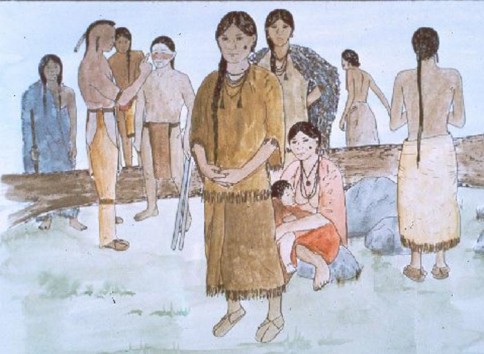
- Clothing — When the Florentine navigator Giovanni da Verrazano first saw the Lenape along the East Coast in 1524 he wrote, “These people are the most beautiful and have the most civil customs that we have found on this voyage. They are taller than we are, they are a bronze color, some tending more towards whiteness, others to a tawny color; the face is clean-cut, the hair is long, and their manner is sweet and gentle, very like that of the ancients. They have all the proportions belonging to any well built men. Their women are just as shapely and beautiful; very gracious, of attractive manner and pleasant appearance.”
The clothing of the Lenape was simple. The men wore breechclouts and moccasins, with leggings and a robe to cover themselves in cold weather. Women had knee- or calf-length wrap-around skirts and wore fur robes in winter, or a beautiful mantle made from turkey feathers. Ornaments of bone, shell and wampum were sometimes worn as necklaces, or on wrists and ankles.
Illustration courtesy of Herbert C. and John T. Kraft
Delaware Humor

By Jim Rementer
Humor or joking is one of the basic things of human life, and people joke in all societies, but the subject of humor among the Lenape (Delaware Indian), or any American Indian people, has had little attention. In fact, the more one reads of Delaware history, the more one wonders if the Delawares have really had anything to laugh about since the Europeans arrived!
Over the years and in a variety of media—books, motion pictures, and now television—American Indians have generally been characterized as stoic people quite devoid of a sense of humor. We hope this page will help dispel some of that myth. We begin with a favorite cartoon of the man responsible for the original tribal website, Jack Tatum.

Now for some stories:
THE WEATHER FORECAST
One cold, blustery fall day the chief of the Delaware Tribe said to a tribal member, “I think we’re going to have a bad winter.” Naturally, the man told others what the chief had said, and the word got around that the chief could foretell the weather.
As winter approached a group of Delawares went to the chief and asked if it was going to be a bad winter. By this time he had forgotten his earlier prediction and was wondering why they thought he would know. He said, “I’ll tell you tomorrow.” After they left, the chief called the man at the local weather bureau and asked him if it would be a bad winter. The weatherman said, “Oh, yes.”
A couple of weeks later more Delawares went to the chief and asked if it was really going to be a bad winter. Again he said, “I’ll tell you tomorrow,” and after they left, he called the man at the weather bureau and asked him. The weatherman said, “Oh, it really will be bad.”
Several more weeks went by and even more Delawares went to the chief and asked if it was truly going to be a bad winter, and they got the reply, “I’ll tell you tomorrow.” Once again he called the man at the weather bureau and asked him. The weatherman said, “Oh, it is going to be the worst in years!”
By now the chief was curious, and he asked the weatherman, “How exactly do you know this?” The weatherman said, “Well, I’ve been watching these Delaware Indians. They have ways of knowing these things, and they’ve been chopping wood like crazy for weeks!”
THE FISHERMAN
This Delaware Indian from Moraviantown went ice fishing. He cut his hole in the ice but didn’t have much luck. But there was a white guy not far away who was hauling in lots of fish, one after another.
So the Indian went over to the guy and said, “What are you doing to catch all those fish? I’m just over there, and I’m not catching anything.”
The guy answered in a muffled voice, “Ee yer erms orm.”
The Indian didn’t understand.
And the guy tried to speak again, “Eeyer erms orm.”
The Indian still couldn’t understand him, so the guy spit something off to the side, and he said, “I said… keep your worms warm!”
THE HUNTING DOG
An Delaware Indian man had a really good hunting dog, and he was always bringing in game. A white man who lived nearby wanted to buy the dog. He offered the Indian $100, but the Indian man said no. Every time they’d meet he’d offer a little more
until finally the price got up to $500. At that price the Indian man sold him the dog.
The next morning the white man took the dog out and they went hunting. He turned the dog loose and the dog went about fifteen feet and laid down and wouldn’t move any more.
So the white guy went to the Indian complaining about how worthless that dog was. The Indian guy said, “Well, let’s go hunting together in the morning and I’ll see what the problem is.”
The next morning they went out together, and the white man turned the dog loose and again the dog only went about fifteen feet and laid down. The white guy said, “See there! He’s worthless!”
So the Delaware man said, “Let me see,” and walked over to where the dog was. He called the white man over and asked him, “What’s the problem? Can’t you see he’s pointing with his lips?” [An old custom with a number of Indian tribes.]
HOW MANY INDIANS?
Q: How many Indians does it take to change a light bulb?
A: One – plus two anthropologists to takes notes of the actions he is performing (and the significance of which they will heatedly debate for years to come), and one ethnologist to study the underlying meaning of the direction the bulb is screwed into the socket, and one linguist in case the Indian says anything.
TO BE BORN
One Indian man was asked if he was born in the hospital. His response was, “Yes, I decided it would be a good time to be near my mother.”
WHAT’S THE PROBLEM?
A Delaware elder was in the Indian Hospital and they were trying to figure out what his health problem was. Finally a doctor came into his room and said, “Good news, I have figured out the cause of your problem.”
“What is it?” the elder asked.
“It’s your teeth,” replied the doctor.
“My teeth? Are you sure?”
“Oh, yes, that’s your problem.”
The Delaware man reached into his mouth and removed his upper and lower plate and laid them on the table and told the doctor, “You show me which one is causing the problem and I’ll break it off!”
THE HUNTER AND THE BEAR
One old man … was somewhat of a braggart, and he told the people, “When I go hunting, if I kill a bear I don’t have to drag him up. I just go out there and nudge him, and tell him, ‘Right over there is the direct route to my home!’”
He said the bear would take in after him and chase him, and after he got him close to his home, he would just shoot him.That way he wouldn’t have a long ways to pack him.
RUN UP AND DOWN
Some years ago, James Nairn, a Delaware Indian, County Attorney in Nowata County, Oklahoma, was cross-examining an old fullblood Cherokee Indian about the position of the doors, windows and rooms in a house where a fight of serious nature had occurred.
“And now,” said Mr. Nairn, “will you tell the Court how the stairs run in the house.”
‘Wall,” he said, “when I am upstairs they run down, an’ when I am downstairs they run up.”
DROOLING
Delaware women like to joke too, and they come up with some quick and witty responses. The following is an example:
At a tribal gathering a man went over to speak to a Delaware woman he knew. As she was seated, and the place was fairly noisy, he bent over to talk to her. He had a piece of ice in his mouth, and as he started to speak he almost drooled, so he quickly stood up straight.
“What’s the matter?” she asked.
“I have some ice in my mouth and I almost drooled on you,” he replied.
Her response was, “Oh, go ahead! It’s been a long time since I’ve had a man drool over me.”
JUST GRINS
Two Indian women were discussing the merits and faults of their respective husbands. “Mary,” said Mollie, “does your ole man talk in his sleep?”
“Nah,” replied Mary, “I jus’ wish he would. All he does is jus’ lay there an’ grin.”
THE INDIAN AGENTS
These two Indian agents were riding in the country when their car broke down. Soon an Indian and his family came along in an old pickup truck, and he offered to give them a ride into town. The Indian got out and told them they have to ride in the back, and he opened the tailgate and let them in.
On the way into town they had to cross a very old and rickety bridge, and when they got to the middle of it, the bridge collapsed, and the truck fell into the river and sank. The Indian and his family were able to open the windows and swim to safety, but the Indian agents drowned. They couldn’t figure out how to open the tailgate.
A DELAWARE’S PRAYER
A Delaware woman was at a church meeting one time, and she was praying in her Lenape language. The next morning, one old Lenape man told another man, “I think that woman knows bad medicine!”
“Why do you think that?” the other man asked.
“I heard her praying that she wanted God to watch over her as she flew through the air.”
He didn’t realize she was leaving the following week on a plane trip to Canada.
THE LAWYER
Some of the Indian humor was even reported in the early newspapers as in this example from the Bartlesville Magnet, 31 August 1900:
There was a lawyer in the Indian country who had none too good a reputation for honesty. One of the aborigines employed him to do a little legal business. It was done to the client’s satisfaction, the fee duly paid, and a receipt for it duly demanded.
“A receipt isn’t necessary,” the lawyer said.
“But I want it,” replied the red man. There was some argument, and the attorney finally demanded his reason. “Since becoming a Christian I have been very careful in all my dealings, that I may be ready for the judgment,” answered the brave sententiously, “and when that day comes I don’t want to take time to go to the bad place to get my receipt from you.”
The receipt was made out and delivered promptly.
NO ONE LOST
The Delawares located in western Oklahoma also had their humor:
Eli Reynolds, a member of the Delaware and Caddo Tribes, was delegated one day by the Superintendent of the Kiowa Indian Agency, at Anadarko, Oklahoma, to accompany a group of easterners on a tour of the Indian Reservation. After due time they arrived at the banks of the Washita River.
“Has anybody been lost in crossing this river,” asked one of the group.
“Nope,” replied Eli, “One Indian drowned here las’ week, but we found him th’ nex’ day.”
NO WHITES AROUND
Here is an example from the Delawares on the Six Nations Reserve in Ontario, Canada in their version of one of the favorite jokes among many Indian tribes concerning the White people:
The Indians of that era were jolly, jocular people. They laughed easily, perhaps because they knew so much of want and suffering. They had known poverty, hunger and racial discrimination. The Indian had a real sense of humour, in spite of his hardships. He took time to talk to anyone he met on the street… A favorite story concerned a Whiteman who asked an Indian if it was safe to leave his rifle on the reserve. “Don’t worry,” replied the Indian. “There isn’t a Whiteman within six miles.”
HAS BEEN
Some good jokes come from members of other tribes who are married to Delawares, as in this example:
Amos Tiger, a professional lightweight champion boxer and a fullblood Euchee Indian who is married to a Delaware, tells this story on one of his fellow tribesmen:
“One day, Micco Behan, an old fullblood, walked into a restaurant in Sapulpa, Oklahoma, and asked for a full course dinner. In due time, the waitress brought in the first course which consisted of soup.
“‘Whats thet?’ inquired old Micco.
“‘That’s bean soup,’ replied the waitress.
“‘Well,’ retorted the old man, ‘I ain’t asking you what it’s been, I want to know what it is now’.”
THE YOUNG MAN’S PRAYER
A certain young Indian man had never learned the language of his people, and when he started going to meetings he noticed that many of the older people prayed in their own language. He was too lazy to take the time to learn all the language, so one night he secretly brought a tape recorder into the meeting and recorded some of these prayers.
He was especially fond of a prayer given by one of the women, so he learned it by heart. Later, when he was at a meeting with some of the older people, he decided to say it with the thought of impressing everyone.
The next morning he asked one old man what he thought of his prayer, and the old man told him, “Say, that was sure a good one! But I didn’t understand what you meant when you asked God to help you when you had your period.”
BLACK BEAVER AND THE COMANCHE
Black Beaver was a famous Delaware, and on numerous occasions he would serve as interpreter or guide on expeditions. He was also noted for his wit and a number of humorous stories exist about him. This story which took place in 1849 was reported by an Army Captain Randolph Marcy. Three different versions exist, and the one below is a blending of the three.
One evening I found Black Beaver and a Comanche guide seated by the fire and they were engaged in a very earnest and not very amicable conversation. I asked what the problem was.
Beaver answered, “I’ve been telling this Comanche what I’ve seen among the white folks.”
I said, “Well, Beaver, what did you tell him?”
“I told him about the steamboats, and the heap of houses I saw in St. Louis.”
“Well, sir, what did he think of that?”
“He said I’m telling him a damn lie!”
“Well, what else did you tell him?”
“I told him about the railroads, but he still thought I’m telling him a lie.”
So I said to Beaver, “Tell him about the magnetic telegraph.”
“What’s that?” said Beaver.
I said, “You’ve heard of New York and New Orleans? Say we have a wire connecting those two cities about a thousand miles apart, and which would take a man thirty days to ride on a good horse. The man at one end of the wire touches it a few times and asks his friend at the other end of the wire what he had for breakfast. His friend at the other end touches it a few times and sends the answer within ten minutes—ham and eggs. Tell the Comanche about that, Beaver.”
“No. Captain, I won’t tell him that, for I don’t believe that myself.”
I assured him that such was the fact, and that I had seen it myself.
Black Beaver replied, “Indian can holler pretty loud, maybe so you hear him for half a mile. But now you say white man can talk thousand miles! I suspect you try to fool me now, Captain; maybe so you lie!”
[Note: We can only wonder what Black Beaver would have thought of the Internet].
There are many more examples that could be given. Keep watching this page for new stories. This should show that no matter what the definition of humor might be, these stories clearly show what a good sense of humor the Lenape people have.
Lenape Stories
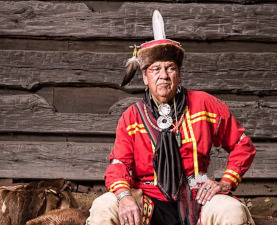
The Lenape had many stories and a number of them can be found in the Lenape Talking Dictionary, www.talk-lenape.org. There are many more stories that were told to researchers over the years but there were no sound files made, only transcriptions. Those stories are shown here with the name of the storyteller, when known, as well as a bit of biographical information of the storyteller, and the name of the person who took down the story.
Introduction to Delaware Storytellers (PDF)
Three Boys on a Vision Quest (PDF)
Lulus (PDF)
The Giant Snake (PDF)
The Panther (PDF)
Why the Crane Has a Long Neck (PDF)
The Hunter and His Dogs (PDF)
The Otter Skin Dance (PDF)
The Hunter and the Cave (PDF)
Thunder Myth (PDF)
Why The World Doesn’t End (PDF)
Snow Boy (PDF)
Son in Law (PDF)
The Horned Serpent (PDF)
The Boy and the Squirrel (PDF)
The Boy Who Had Dog Power (PDF)
The Big Fish and the Sun (PDF)
Mitsi (PDF)
Man Who Lived with Thunders (PDF)
Disappearance of Mother Corn (PDF)
Ball Player (PDF)
The Lost Boy (PDF)
The Mother Bear (PDF)
Why The Raccoon Has Marks on His Face (PDF)
A Deer Tells Something (PDF)
The Woman with The Two Plants (PDF)
The Little People (PDF)
The Man and His Horse (PDF)
The Beautiful Woman (PDF)
The Story of Mahtahis (PDF)
Why the Dove Builds a Nest the Way he Does (PDF)
The Good Looking Woman (PDF)
A Wehixamukes Story (PDF)
The Giants (PDF)
The Origin of the Bittersweet Vine (PDF)
A Delaware Snake Legend (PDF)
A Thunder Myth (PDF)
His Plea (PDF)
Horned Serpent (PDF)
He Sinks Into the Earth (PDF)
The Man Who Wanted Love Medicine (PDF)
The Girl Who Joined The Thunders (PDF)
Rock Shut Up (PDF)
The Telegraph (PDF)
Origin of the Otter Ceremony (PDF)
On a Train (PDF)
The Weather Forecast (PDF)
The Two Children (PDF)
Making a Wish (PDF)
Did You Make a Garden (PDF)
Indian Rights (PDF)
The Fire Engine (PDF)
Friendly Indians (PDF)
Push (PDF)
Fallen Leaf Lake (PDF)
Dedication of the Social Services Building, May 22, 2013
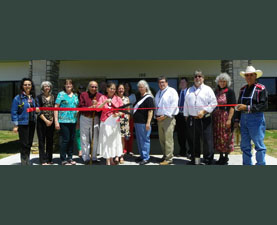
On Wednesday, May 22, the Delaware Tribe of Indians proudly officially opened its new Social Services Building at 166 NE Barbara on the Tribe’s Bartlesville campus. Former chief Dee Ketchum performed the smoke-off ceremony, after which Chief Pechonick and the other members of the Tribal Council were joined by Bartlesville Chamber of Commerce officials for the ribbon-cutting.
We invite tribal members and others to visit this new facility, which includes our Housing, Social Services, Education, and Environmental Programs as well as the Library, Museum, and Archives.
We also want to acknowledge our new Memorial Garden north of the pond across the street from the Social Services building. Thanks to tribal employee Gina Roth and her son Trey for their hard work getting it set up.
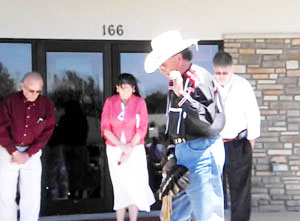 |
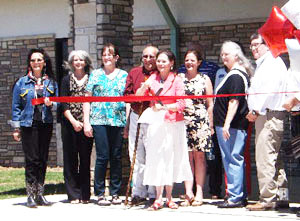 |
| Former chief Dee Ketchum burns cedar and offers a prayer at the dedication. | Chief Pechonick cuts the ribbon. |
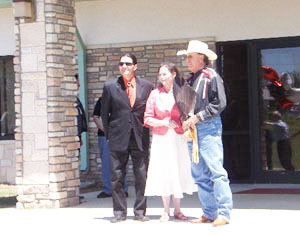 |
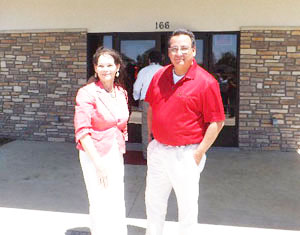 |
| Tribal Manager Curtis Zunigha, Chief Paula Pechonick, and former chief Dee Ketchum after the ribbon cutting. | Chief Paula Pechonick and Jim Gray. |
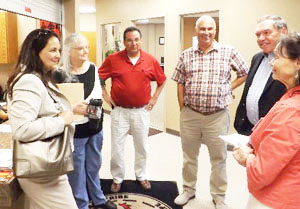 |
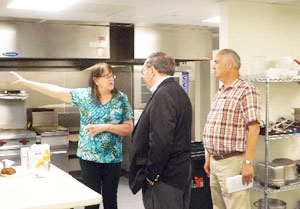 |
| Chief Pechonick with representatives from Cherokee Nation. | Councilwoman Janifer Brown gives Lee Keener and Jack Baker of Cherokee Nation a tour of the new kitchen. |
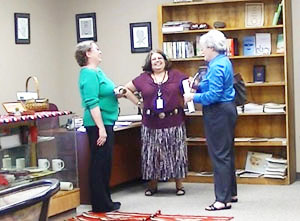 |
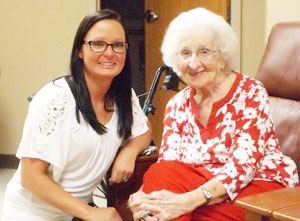 |
| Tribal Archivist Anita Mathis with Debbie Neece and Joan Singleton of the Bartlesville History Museum. | Coke Meyers, a relative of Will Rogers and the oldest member of the Washington County Historical Society, with its youngest member, Social Services Manager Lacey Harris. |
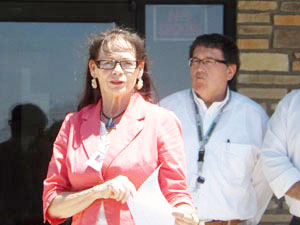 |
 |
| Chief Pechonick addresses the crowd. | Tribal elder Jack Tatum enjoys the new Memorial Garden. |
Delaware Tribe Visits Confederated Salish and Kootenai Tribes

Members of the Tribal Council recently visited Pablo, Montana to tour the tribal operations of the Confederated Salish and Kootenai. The two-day visit allowed the Tribal Council to meet with department heads to share ideas on how to expand on similar ventures, as well as learn how to establish and run new ones.


 D5 Creation
D5 Creation